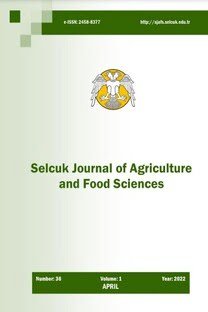Kekik yağının Xanthomonas axonopodis pv. vesicatoria'ya karşı in vitro ve in vivo etkileri
uçucu yağ bitkileri, Xanthomonas axonopodis, antiseptikler, uçucu yağlar
In vitro and in vivo effects of essential oil of oregano on Xanthomonas axonopodis pv. vesicatoria (Doidge) dye
essential oil plants, Xanthomonas axonopodis, antiseptics, essential oils,
___
- Akgül, A., M. Kıvanç, 1988. Inhibitory effects of six Turkish thyme-like spices on some common food-borne bacteria. Die Nahrung 32. 201-203. Basım. H., 1996. Horizontal Chromosomal Gene transfer Among Strains of Xanthomonas axonopodis pv. vesicatoria by Conjugation. PhD. Dissertation. University of Florida, Department of Plant Pathology. USA 137 p. Basım, H., O. Yeğen, W. Zeller. 1997. In vitro activities of essential oil of Thymbra spicata var. spicata on plant pathogenic bacteria. Symposium Ober Wissenschaftliche Ergebnisse Deutsch-Turkischer Universltatpartnerschaften hn Agrarbereich, (Türk ve Alman Üniversiteleri İşbirliğinin Tarım Alanındaki Bilimsel Araştırına Sonuçlan Sempozyumu), 29 Eylül - Ekim. Antalya, 5 : 78-79. Belaiche, P., 1963. Trattato di Fitoterapia e Aromoterapia. Vol. 1. Studio Edizioni, Milano. Bello, D., 1942. Ricerche sperimentali sul potere microbicida di alcuni olii animali e vegetali sullo Stafilococco piogene aureo. Rivista ıtal., Igiene 2, 455-469. Benouda, A.M. Hassar, B. Benjılalı, 1988. Antiseptic properties of essential oils in vitro, tested against pathogenic hospital microorganisms. Fitoterapia 59, 115-119. Cabo, J., M.E. Crespo, J. Jimenez, C. Wavarrp, A. Zarzuelo, 1987. A pharmacodynamic study of the Thymus orospedanus, Fitoterapia 58, 39-44. Canteros, B.I., G.V. Minsavage, J.B. Jones, R.E. Stall, 1995, Diversity of plasmids in Xanthomonas campestris pv. vesicatoria. Phytopathology 85 : 1482-1486. Chamberland, M., 1887. Les essences au point der vue de leurs proprietes antiseptiques. Ann. Inst. Pasteur 1. 153-164.
- ISSN: 1300-5774
- Yayın Aralığı: Yılda 3 Sayı
- Başlangıç: 2018
- Yayıncı: Selçuk Üniv. Ziraat Fak.
Konya il merkezinde kentsel gelişim ve tarım arazilerinin amaç dışı kullanımı
H. Hüseyin ÖZAYTEKİN, Cevdet ŞEKER, Mithat DİREK, Saim KARAKAPLAN
Buğday tohumunun çimlenmesine çürütülmüş bitkisel artıkların etkisi
Refik UYANGÖZ, Ramazan ACAR, Kemal GÜR, Mevlüt MÜLAYİM
$CaCl_2$ ilavesi ve salamura kürleme yönteminin pastırmanın bazı kalite özelliklerine etkisi
Akkaraman, İvesi ve İvesi x Akkaraman melezi $(F_1xG_1)$ koyunların süt verim özellikleri
Saim BOZTEPE, Ayhan ÖZTÜRK, Birol DAĞ, Abdurrahman TOZLUCA, Sinan S. PARLAT
Konya'da kentsel gelişimlerin tarımsal alan kayıplarına etkileri üzerinde bir araştırma
Tarla bitkilerinde çekirdek DNS'sı miktarları
Mehmet BABOĞLU, Süleyman SOYLU, MUSTAFA YORGANCILAR
Kekik yağının Xanthomonas axonopodis pv. vesicatoria'ya karşı in vitro ve in vivo etkileri
